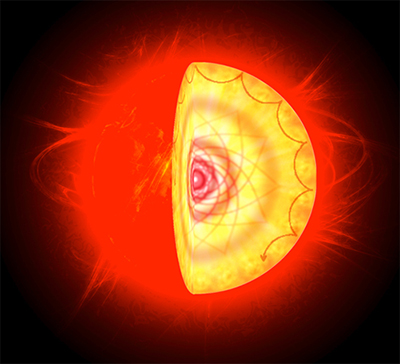The inner lives of red giant stars
Apr 6, 2011 - by Staff
Apr 6, 2011 - by Staff
April 6, 2011 | An international team of astronomers that includes NCAR’s Savita Mathur has observed mixed waves—a mixture of acoustic and gravity waves—that run all the way to the cores of red giant stars. Astronomers already knew that such waves (known as stellar oscillations) existed, but until now had only observed pure acoustic waves traveling through the outer parts of stars. In the same way that scientists use sound waves to learn about Earth’s interior, the discovery, which was published in Science in March, opens a window for learning about the interiors of red giants.
The discovery came about when astronomers were analyzing data from NASA’s powerful Kepler space telescope and noticed that some stellar oscillations behaved differently than others. By comparing these observations with theoretical models, they realized that they were viewing the signatures of mixed waves that “sense” the heart of a star.
“This is a very exciting result, showing that asteroseismology is a great tool to better understand stars and probe their interiors,” Mathur says.
A red giant is similar to our Sun but is in the last phase of its life. (The Sun will be a red giant in about five billion years.) Having exhausted the supply of hydrogen in its core that powers nuclear fusion, a red giant instead burns hydrogen in a surrounding shell. At the end of its life and when massive enough, it burns helium in its core, and its color changes from yellow to reddish.
In related research published in Nature, the discovery is helping astronomers determine where stars are in the evolution from infancy to death. The Kepler telescope allows researchers to continuously study starlight from hundreds of red giants in unprecedented detail. Changes in brightness at the surface reflect stellar oscillations traveling through a star’s interior and back. Under the right conditions, these waves interact with other waves trapped inside the star’s helium core. The resulting mixed oscillation modes can reveal whether a star has run out of hydrogen and is now burning helium, indicating that it is at a later stage in life.

This red giant image shows acoustic waves reflected at the surface and gravity waves in the core. (Image courtesy SAp/CEA.)